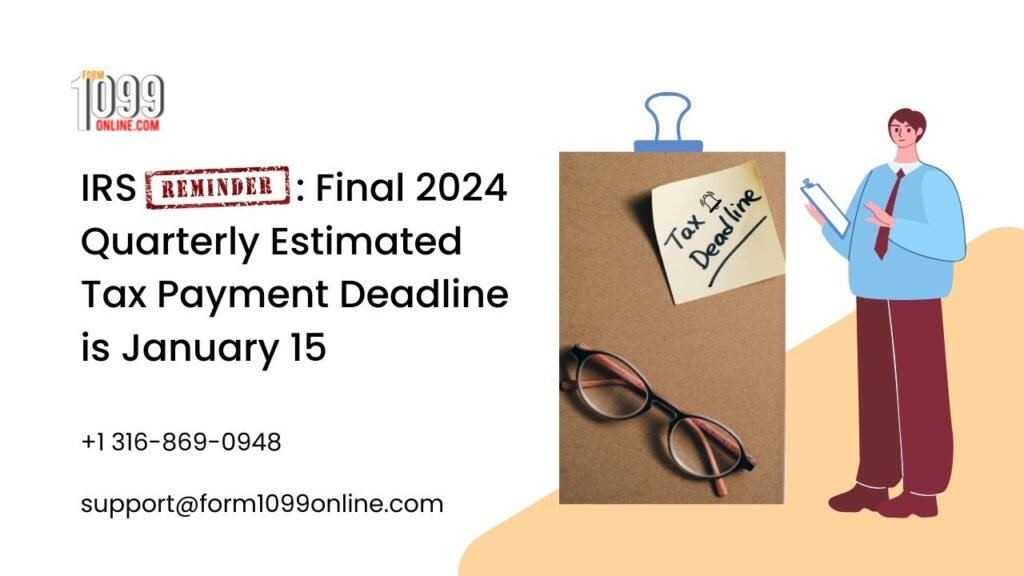As the new year unfolds, it’s crucial for taxpayers who make quarterly estimated tax payments to remember an important deadline: January 15, 2025. This date marks the final chance to pay the fourth-quarter estimated taxes for the 2024 tax year. Failing to meet this deadline can lead to penalties and interest, so it’s important to act now. Here’s what you need to know about the IRS reminder for the final 2024 quarterly estimated tax payment and how to avoid unnecessary stress.
Table of Contents
What Are Quarterly Estimated Tax Payments?
Quarterly estimated tax payments are made by individuals, including freelancers, self-employed workers, and small business owners, who don’t have taxes automatically withheld from their income. The IRS requires these payments to ensure that individuals pay their tax liabilities throughout the year rather than in a lump sum when filing their tax returns.
Typically, these payments are due in four installments:
- April 15 (First Quarter)
- June 15 (Second Quarter)
- September 15 (Third Quarter)
- January 15 (Fourth Quarter)
For 2024, the final payment must be submitted by January 15, 2025, so you can avoid any penalties for underpayment.
Why Is the January 15 Deadline Important?
The January 15 deadline is crucial for several reasons:
- Avoid Penalties: If you don’t pay the full amount of estimated taxes owed by the due date, the IRS can impose penalties and interest on any unpaid amounts.
- Stay Compliant with Tax Laws: The IRS expects taxpayers to pay their tax liability throughout the year. Missing the final payment may create unnecessary complications during tax filing.
- Boost Your Refund or Reduce Owed Taxes: Making this payment can help you reduce any potential tax bill when filing your return or might even increase your refund.
How to Calculate Your Estimated Tax Payments?
To calculate your estimated tax payments, follow these steps:
- Estimate Your Total Income: Add up all the sources of income you expect to receive in 2024, including wages, freelance income, investment earnings, etc.
- Calculate Deductions and Credits: Subtract allowable deductions (such as business expenses or retirement contributions) and apply any available credits to reduce taxable income.
- Apply the Appropriate Tax Rate: Use IRS tax tables or online tools to calculate the tax liability based on your estimated income, deductions, and credits.
- Divide by Four: Once you’ve determined your estimated annual tax liability, divide it by four to find the amount due each quarter.
How to Make Your Estimated Tax Payment?
There are several convenient ways to submit your final quarterly estimated tax payment to the IRS:
- Online: The IRS recommends using IRS Direct Pay or the Electronic Federal Tax Payment System (EFTPS) for secure, free payments.
- Check or Money Order: If you prefer to mail your payment, ensure you send it to the correct address listed on the IRS website or the IRS form 1040-ES.
- Debit or Credit Card: You can also use a third-party service to make payments by debit or credit card. However, be aware that these services charge a processing fee.
Make sure you pay on time to avoid penalties. Remember, January 15 is the last day for the final payment!
What Happens If You Miss the January 15 Deadline?
Missing the January 15 deadline may result in:
- Penalties for Late Payment: The IRS can impose penalties for late payments, which are calculated based on how much you owe and how long the payment is delayed.
- Interest on Unpaid Taxes: In addition to penalties, you will also accrue interest on any unpaid balance, which can significantly increase the amount owed.
If you miss the deadline, the best course of action is to pay as soon as possible to minimize penalties and interest. You can also consider contacting the IRS to discuss potential relief options.
IRS Payment Options for Self-Employed Individuals and Small Business Owners
For those who are self-employed or small business owners, estimated tax payments may be more complicated due to fluctuating income or expenses. It’s important to track income carefully throughout the year and stay on top of estimated tax payments to avoid penalties.
The IRS provides tools to help with the process:
- IRS Form 1040-ES: This form provides worksheets to help you calculate and track your estimated tax payments.
- Online Resources: The IRS offers an Estimated Tax Worksheet and payment calculators to assist in determining how much you owe.
You can also work with a tax professional to ensure you’re calculating your payments accurately and making them on time.
Tax Tips for Freelancers and Small Business Owners
Freelancers and business owners should consider the following tips to manage quarterly tax payments efficiently:
- Track Your Income and Expenses Regularly: Keep detailed records of all income and expenses throughout the year. This will make it easier to estimate taxes accurately.
- Set Aside Money for Taxes: When you receive payments, set aside a portion to cover your taxes. This will help ensure that you have enough funds when the quarterly payments are due.
- Consider Estimated Tax Penalty Relief: If you’ve missed a payment due to unforeseen circumstances, the IRS may offer relief from penalties if you meet certain criteria.
Conclusion
The final 2024 quarterly estimated tax payment is due on January 15, 2025. To avoid penalties and ensure compliance, it’s crucial to submit your payment on time. If you’re unsure of the amount you owe or how to calculate your payments, use IRS resources or consult with a tax professional to help you stay on track.
At Form1099Online.com, we provide resources and tools to help freelancers, small business owners, and other taxpayers file their taxes with ease. Stay ahead of your taxes, and make sure to complete your final estimated payment by the January 15 deadline to keep your finances in good shape.

